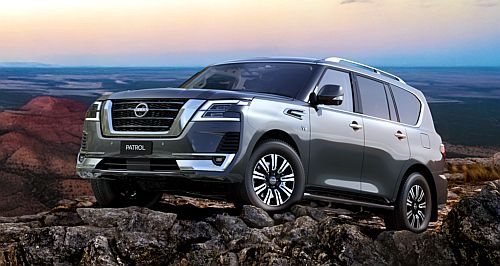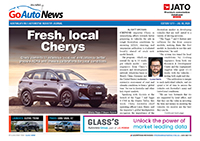Make / Model Search
News - Nissan - PatrolNVES raises Nissan Patrol price by $5KEmissions rules hit price of popular ICE models, as Nissan Patrol slapped with $5K hike4 Aug 2025 A FORTNIGHT after Ford Australia slapped a $5,000 New Vehicle Efficiency Standard (NVES) premium on its turbocharged four cylinder and V8-powered Mustang sportscar range to pay emissions fines, Nissan Australia has followed suit with a $5K NVES hit on its popular, three model and “high polluting” Patrol Y62 line-up.
The new +$5K schedule moves the 5.6-litre petrol V8 Patrol Ti up to $95,600, the Ti-L to $107,100 and the Warrior to $110,660 all excluding on road costs and effective 1 August.
Nissan (and Ford) are coy about lumping the $5K imposts on the NVES alone diverting attention towards other factors such as transport costs, fluctuating exchange rates, increasing production costs, market dynamics, and the like.
The Y62-series Patrol is more than a decade old and is one of the highest-polluting cars on sale today but has enjoyed exponential sales growth in the run up to a new generation Y63-series turbo V6 model due sometime next year.
The Y62 emits 334 grams per kilometre of CO2 according to its official ADR lab-test result, against a target of 216g/km for light-commercial vehicles – including off-road SUVs – for 2025.
According to Australia publication Drive, the latest price rise for the Nissan Patrol follows the launch of an updated Model Year 2025 (MY25) version earlier this year, which introduced a revised interior first seen overseas five years ago, for between $140 and $1340 more than before.
“A range-wide $360 price increase also applied in Australia from 1 January 2025, making a new MY25 Patrol Ti $6700 dearer than an MY24 version ordered seven months ago,” it said
“While the fines can be offset by lower-emission vehicles, such as its Ariya BEV and e-power hybrid versions of Qashqai and Xtrail, it would mean Nissan Australia would face a fine of $11,600 if it sold a single Patrol in the second half of 2025.”
As the CO2 targets become stricter each year, the fines could increase, given that the Patrol Y62 will be available until late 2026 or early 2027, when the new-generation Patrol Y63 is due to launch in Australia.
“The Patrol Y63 will need to meet a stricter emissions standard in Australia – based on Europe's Euro 6d rules – from day one as it will be enforced from December 1, 2025, for newly introduced 'light vehicles',” the publication added.
“Currently, Patrol Y62 is officially categorised as a 'heavy vehicle' as its gross vehicle mass (GVM) exceeds 3500kg, meaning it would need to meet the Euro 6 standard by November 2025.
“However, Nissan is likely to re-categorise the Patrol Y62 as a 'light vehicle' by reducing its GVM to 3500kg or less, affording it more time as a Euro 5-compliant vehicle, while slightly cutting down its payload capacity.”
The NVES penalises new vehicle importers at a rate of $100 per gram of CO2 per kilometre if its vehicles emit above a predetermined level and is predicted to generate some $2.8 billion in fines by 2029.
It works by setting average carbon dioxide (CO2) emissions targets for each manufacturer's vehicle line-up.
If a brand’s average CO2 emissions exceed the target, they incur a penalty. These penalties could be passed on to consumers through increased vehicle prices or absorbed by the manufacturers through reduced profit margins.
The NVES is designed to incentivise carmakers to introduce more fuel-efficient vehicles and technologies, including electric vehicles (EVs).
Manufacturers have several options to meet the targets, including introducing new low-emission vehicles, purchasing credits from EV-only manufacturers, adjusting vehicle prices, or potentially exiting the market if unable to comply.
Similar imposts may be expected across other makes and models as the effects of the NVES make their presence felt (as of 1 July).
Some importers can/may offset NVES penalties by selling low-emission and new energy vehicles, while others have little choice but to pass fines on to its customers.
Some other popular brands potentially inline for NVES imposts include Ford which is predicted to struggle with meeting the targets for both passenger vehicles and utes/vans.
Nissan is likely to face penalties for passenger vehicles, again potentially including utes/vans.
Mazda is predicted to face penalties for both passenger vehicles and utes.
Despite having an extensive range of hybrid vehicles available, buyers of popular Toyota models like the LandCruiser 300 Series and HiLux may incur penalties if not offset by the sales of low-emission vehicles.
Mitsubishi is predicted to face penalties, especially with its diesel-powered Triton.
Hyundai may face penalties for passenger vehicles but may meet commercial vehicle standards with a new hybrid ute.
Isuzu is likely to struggle due to its reliance on diesel-powered utes and SUVs alone.
GWM may struggle to meet the passenger vehicle target.
Kia may struggle to meet the passenger vehicle target.
 Read more30th of July 2025  Nissan Ariya orders now openNissan prices its all-electric Ariya for Australia ahead of domestic debut in September10th of July 2025  Nissan to offer heritage colour option on ZIconic R34 GT-R Bayside Blue to be offered as one of three new Z paint options8th of July 2025  Qashqai Ti e-Power joins the ranksNissan set to broaden Qashqai e-Power range with more accessible Ti model grade2nd of July 2025  Nissan to cut UK jobs: reportJobs go at Sunderland plant in Britain as Nissan desperately tries to save cash |
Click to shareNissan articlesResearch Nissan Patrol pricing
Motor industry news |











Facebook Twitter Instagram